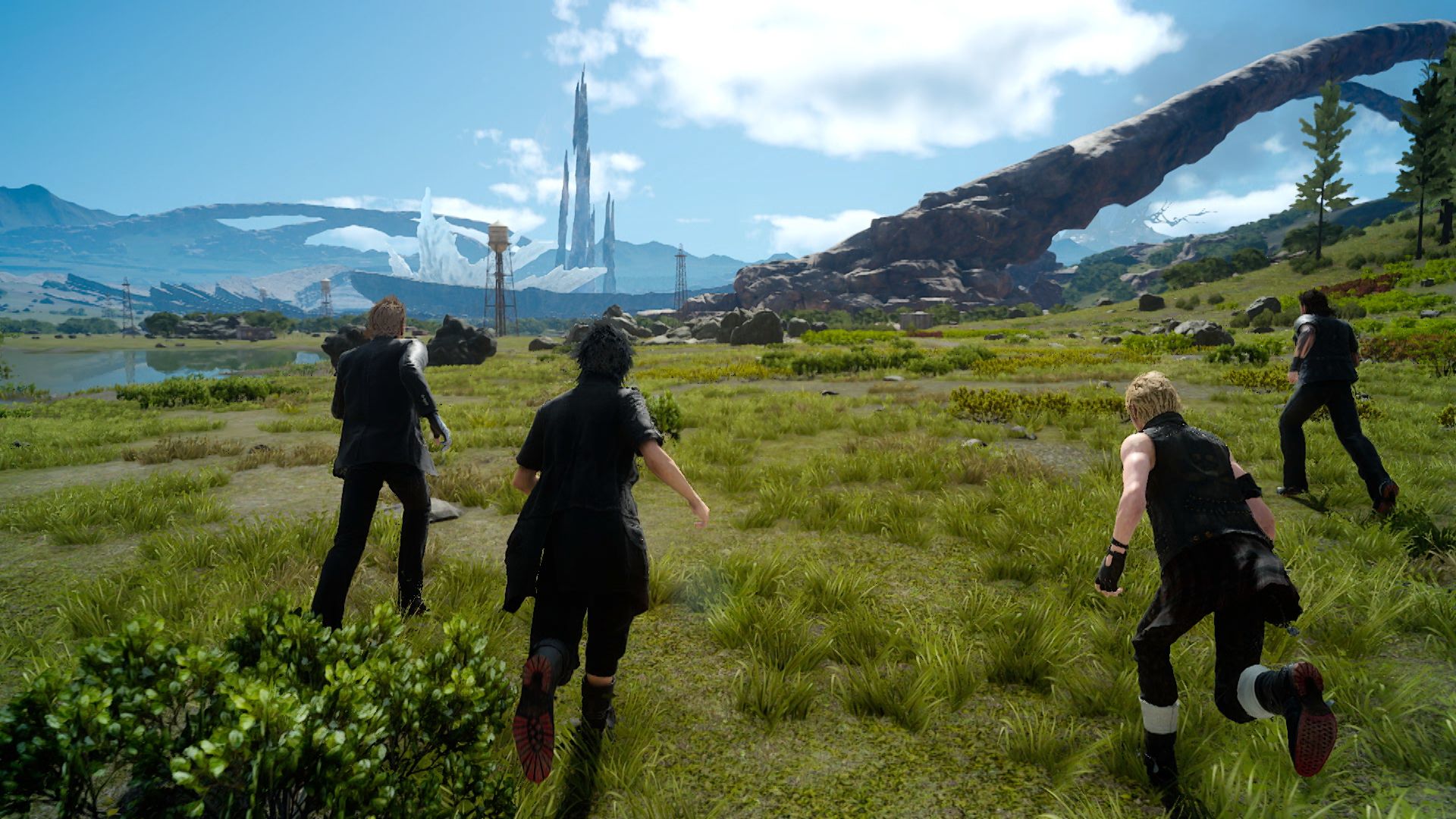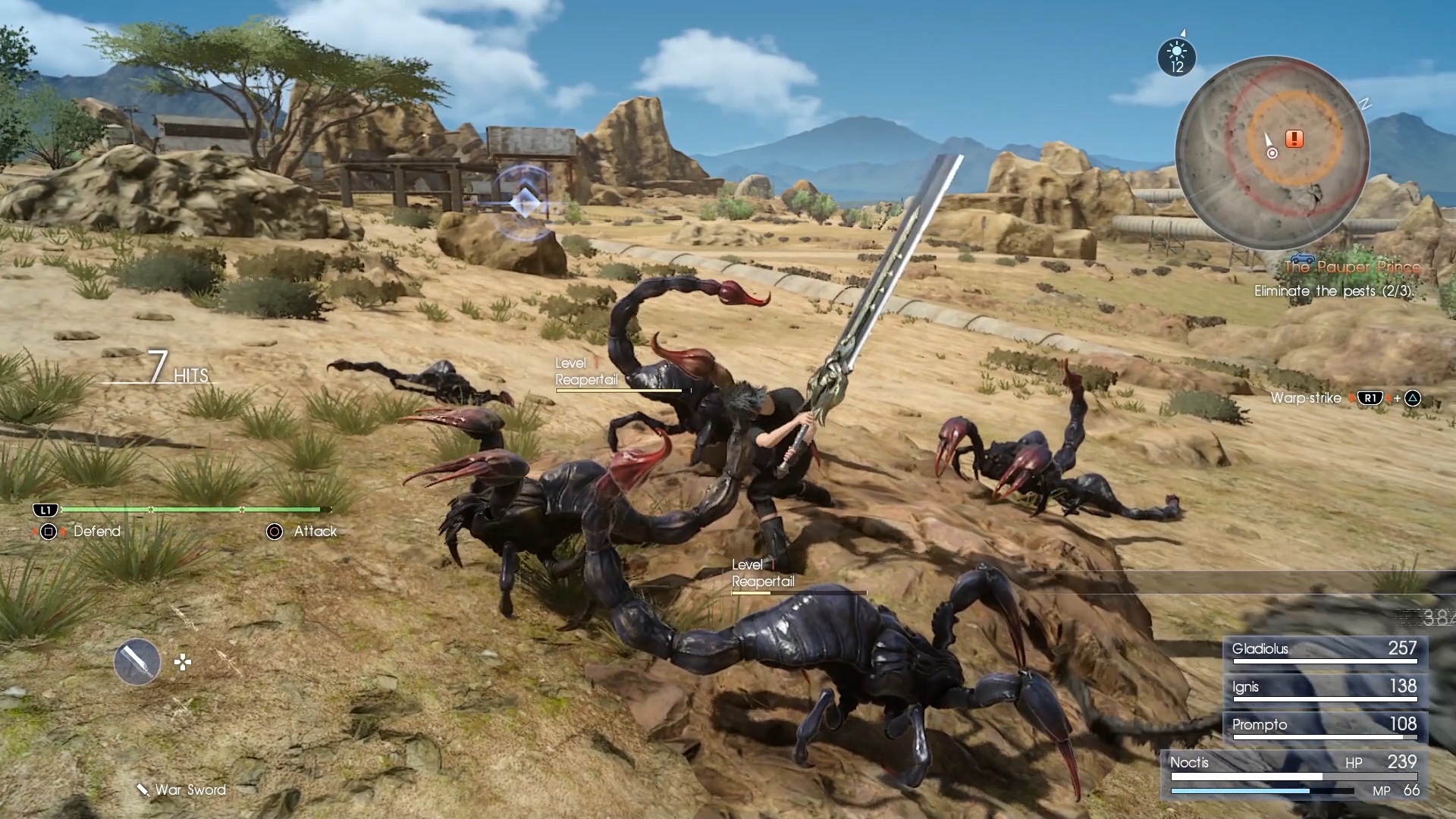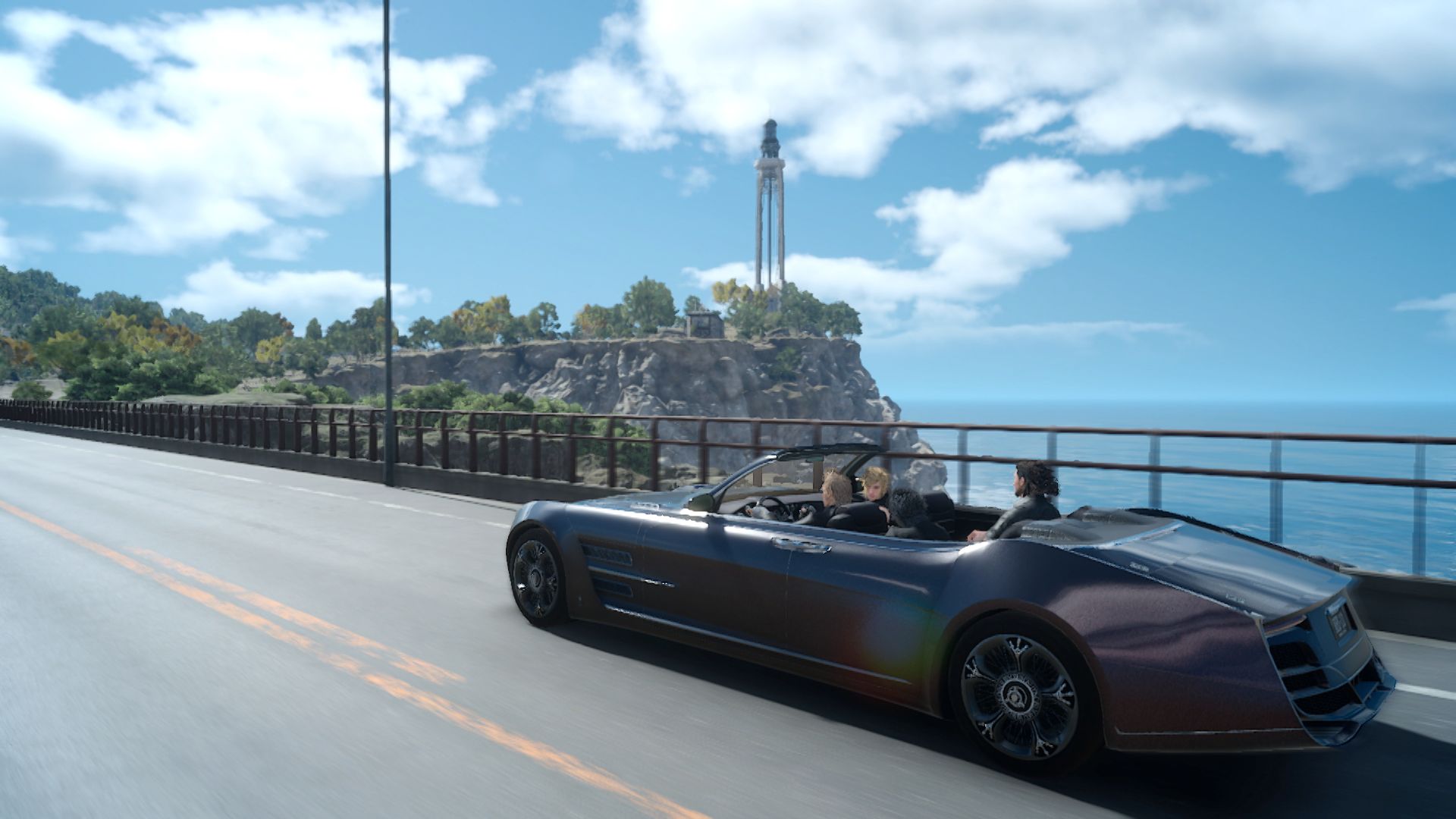Somehow they pulled it off. Don’t ask me how, but Final Fantasy XV is not the sputtering dumpster fire some worried was inbound after years of developmental tumult. It is, in fact, the opposite, however improbable that sounds after middling entries like 2014’s Lightning Returns: Final Fantasy XIII, and the disastrous original launch of Final Fantasy XIV in 2010. Final Fantasy XV, out November 29 for PlayStation 4 (buy it) and Xbox One (buy it), feels like a glorious return to relevance for Square Enix’s venerable mix of rideable birds, hopping cacti and emo fashion victims.
Start with the story, a simmering bildungsroman spun as a buddy road trip. Our MVP this time is Noctis, the twenty-something son of the ruler of Insomnia, a magically shielded sovereign metropolis that’s coveted by an encroaching empire. As the game begins, Noctis and his boy-band entourage (sporting bardic names like Prompto and Gladiolus) have been dispatched from Insomnia to meet with Noctis’s betrothed, a childhood friend abducted by the empire years earlier. Their marriage is meant to be a diplomatic salve, though if you’ve seen the tie-in film Kingsglaive, you know what happens next. Let’s just say Noctis’s journey upshifts from insouciant gallivanting to a birthright quest that’s part “round up a bunch of mystical relics,” part perambulatory On the Road.
Add godlike abilities, superhuman adversaries, existential crises and actual gods, and you’ve got a proper Wagnerian opera on the boil. Which, granted, sounds like the windup to any of the last few games. The difference here stems from original director Tetsuya Nomura’s re-charting of a franchise celebrated for its exuberant silliness. Some of that remains — would it be a Final Fantasy without the glam rock hairdos and cosmic hokum? — but it’s tempered by a kind of world-building verisimilitude, like Alex Ross turning comic book panels into Norman Rockwell paintings.

It makes for what you’ll probably hear summed as “a darker Final Fantasy.” Which it is, but without the self-serious baggage. There’s no The Dark Knight turn, no fetishizing of violence or stultifying nihilism. There’s likewise no ironic genre dismantling, no 1980s Alan Moore-ification of the game’s heroes and villains for the sake of holding up mirrors. It’s simply the franchise’s obsessions — themes like royal dynasties, New Age metaphysics and introspective voyaging — laid across a naturalist’s canvas. Take it or leave it.
The game’s world of Eos resembles a mishmash of eras lifted from our own, adding to the sense of having landed somewhere weird and wonderful. Mid-20th-century muscle cars vie stylistically with your convertible’s modern concept-Cadillac chassis. Troop carriers with Cylon-red engines swoop down to upchuck gangs of hostile automatons. In the game’s largest city, Venetian gondolas motor along waterways vaulted over rococo facades encircled by Niagara-scale waterfalls like a baroque version of Final Fantasy X‘s Zanarkand. Hit the wilds and you’ll spy rock arches that span miles and tower over bosky valleys like the ribs of a giant. It’s as if someone grafted the grit of CD Projekt Red’s The Witcher 3 and postwar 1950s shtick of the Fallout series onto Monolith Soft’s geologically alien Xenoblade games.
And the creatures inhabiting Final Fantasy XV‘s Earth-like expanse are downright Boschian. Squadrons of Imps or other forms of dungeon-delving demons could be escapees from a gothic church mural. Cthulian Mindflayers and Gygax-ian Liches are chilling in their sepulchral plausibility. Ground-shaking beings tall as the hills rival the unidealized Cretacean reptiles of Jurassic Park. Dungeons unfold like horror films, each purpose-built and flush with jump-scare deathtraps or freakishly realistic foes that scamper from midnight blackness. This is Final Fantasy as imagined by an André Øvredal, the acclaimed director whose 2010 film Trollhunter bent Norwegian folklore through a naturalistic prism to produce a bona fide creep-out.

When you’re not rubbernecking, you’re fighting that stuff in real time or though an optional “wait” mode that pauses the game when you stop moving (if you prefer more thought out, stepwise tactics). Hold a button and Noctis auto-attacks, which sounds infantilizing but in practice frees you to study the battlefield and plot next moves. Like “warp strikes,” which propel Noctis across the battlefield to deal massive damage (greater spans yield higher returns). Or “point warps,” whereby Noctis can escape to a vantage point and either recharge or take aim at the next victim, adding a novel ranged wrinkle. Warping likewise solves what could have been a problem getting around playgrounds that can be as capacious as coliseums.
Most of these pieces are in place early on, which, given how much of the game is about bashing stuff senseless, sounds like a recipe for monotony. Noctis and pals get better gear as the game proceeds, can bolster how much damage they do or receive by boosting abilities in skill trees, and can gin up spells based on elements like fire, ice or electricity with classic this-beats-that correlations. But there are no mid-game surprises, no leaps to secondary systems like Xenoblade Chronicles X‘s battle mechs fighting on different orders of magnitude. It’s instead how your troupe interacts (and, ultimately, what they interact with) that wards off gameplay staleness.
Techniques, for instance, are individuated maneuvers Noctis can ask a friend to perform, with little followups pulled off by hitting a button when prompted. If Noctis parries a blow, a nearby ally may retaliate with a strike of his own, injecting mid-battle flourishes. Techniques can be leveled up or swapped out, adding further offensive or defensive permutations. But it’s the way enemies scale, whether in quantity, geometric complexity (with multiple attackable parts), behavioral idiosyncrasy, or the way those factors recombine, that makes throwing down at the 40 to 60 hour mark as exhilarating as at the outset. Eos’s ecology is vast and diverse, to say nothing of its remarkable boss fights, and no two encounters in Final Fantasy XV play the same.

Design choices that sound weird on paper turn out to be perks, too. When you opt to take the wheel of your car (instead of letting a companion chauffeur you around), you’re locked to the map’s arterial roads and byways, which in an open world sounds like a mistake. Until you realize what a gift it is to be able to gape at the gorgeous scenery unbothered by distractions, like trying not to crash. If you really need an off-road, goes-anywhere vehicle, this is how Final Fantasy XV figures in Chocobos, summonable birds (and a series mainstay) that get zippier and more formidable with repeated use. What at first seems like a constraint turns out to be an enlargement of your options for engagement, in other words.
What’s not to like? Active combat against dozens of enemies can be frenetic to a fault, confounding thoughtful tactics. Wait mode scratches that itch, though against smaller groups of foes Active combat tends to be preferable. An option to toggle between either without having to bring up the menu would have been nice. The game also feels too effortless early on, doling out experience points like candy from a firehose. It’s less of a problem as you head into the later chapters, where the road narrows to allay the problem. But Noctis has so many combat fallbacks that it’s easy to get ahead of the curve, then stay there. Higher difficulty settings that increase damage taken, reduce damage dealt and nerf experience point windfalls (as in The Witcher 3, a game that’s better paced in this regard) could remedy this complaint.
I’m also a little weirded out by the product placement. When you camp, for instance, you’ll see a popular outdoors equipment company’s logo splashed on the backs of the foldout campfire chairs. Pay attention to placards when visiting gas stations and you’ll notice a popular credit card sign in the window, its name suggesting a city like Manhattan’s just down the road. I’m not hung up on ads in games, but in a world like this, subtler feels smarter. Like the party’s outfits, which apparently owe a debt to Japanese fashion outfit Roen and make their case invisibly, on pure stylistic terms.

Otherwise we’re talking about an experience that’s among the series’ finest. Diversions like fishing, cooking and photography amount to collection quests that add modest strategic incentives while rounding out the exploration-for-exploration’s-sake angle. Whether you’re into Yoko Shimomura’s quirky soundtrack or not (I am), you can collect “best of” albums from prior Final Fantasy games by visiting Eos’s sundry shops, each then playable on your car stereo as you cruise around — a rare bit of fan service that’s both nostalgic and purposeful.
And then you have the story itself, a rambling Boys’ Own romp with unusually strong characters and at times even Shakespearean poignancy. The only caveat there is that playing without first viewing the (freely watchable) Brotherhood animated series, or Kingsglaive itself, you’re missing half the backstory.
Something wonderful and improbable must have happened towards the end of the topsy-turvy decade it’s taken Square Enix to finally produce a Final Fantasy worth crowing about. Thank director Hajime Tabata for somehow righting the ship. How he did so could presumably fill a book. How many games get 10 years to simmer? Change captains mid-journey? Have lord knows how many investment dollars (to say nothing of franchise esteem) on the line? And how often does vaporware materialize, after years of elliptical studio messaging, this lively and focused and fully realized?
4.5 out of 5
Reviewed on PlayStation 4 Pro
Get it now:
PlayStation 4
Xbox One
More Must-Reads from TIME
- Cybersecurity Experts Are Sounding the Alarm on DOGE
- Meet the 2025 Women of the Year
- The Harsh Truth About Disability Inclusion
- Why Do More Young Adults Have Cancer?
- Colman Domingo Leads With Radical Love
- How to Get Better at Doing Things Alone
- Michelle Zauner Stares Down the Darkness
Write to Matt Peckham at matt.peckham@time.com